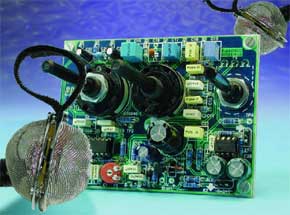Directional Microphone
with switchable characteristic

This is a MEMBER ONLY article. You need a subscription to read this article.
- Unlimited access to online Member Only articles
- 3 new editions Elektor Magazine (digital)
- More than 5000 Gerber files
- 20% member discount on e-books (at elektor.com)
- 10% member discount on Products (at elektor.com)
Available from €5.33 per month.
What is Members Only
Elektor is committed to providing high-quality content on electronics, catering to tens of thousands of paying members. As part of this commitment, Elektor has launched Premium, an initiative that offers exclusive online articles to members sometimes even before they appear in the magazine.
Every day, members can access in-depth articles that showcase the best of Elektor's premium content.
This initiative aims to reward members with early access. Once logged in, members can easily enjoy this exclusive content and engage in discussions about featured projects. While Premium adds to the existing resources available, Elektor will continue to provide a wealth of free information.
Join the Elektor community today to take advantage of Premium and other benefits!
Materials
Gerber file
CAM/CAD data for the PCB referred to in this article is available as a Gerber file. Elektor GREEN and GOLD members can exclusively download these files for free as part of their membership. Gerber files allow a PCB to be produced on an appropriate device available locally, or through an online PCB manufacturing service.
Elektor recommends the Elektor PCB Service service from its business partner Eurocircuits or AISLER as the best services for its own prototypes and volume production.
The use of our Gerber files is provided under a modified Creative Commons license. Creative Commons offers authors, scientists, educators and other creatives the freedom to handle their copyright in a more free way without losing their ownership.
Extra info / Update
Component list
R1,R3,R39 = 4k?7
R2,R4,R37,R38 = 470?
R5,R15,R26,R32 = 47k?
R6,R7,R28 = 22k?
R8,R16,R17,R18,R31 = 1k?
R9,R24 = 100k?
R10 = 3k?3
R11 = 1k?5
R12,R13 = 1k?1
R14 = 2k?4
R19-R22 = 220k?
R23 = 150k?
R25 = 68k?
R27 = 33k?
R29 = 15k?
R30,R33,R34 = 10k?
R35,R36 = 47?
P1 = 47k? preset
P2 = 1k? potentiometer, logarithmic
Capacitors:
C1,C4 = 2nF2
C2,C5,C8,C13 = 330nF
C3,C6 = 220µF 10V radial
C7 = 47nF
C9,C10,C24 = 100nF
C11 = 150nF
C12 = 220nF
C14 = 470nF
C15 = 680nF
C16,C23 = 1µF 63V MKT, lead pitch 5mm or 7.5mm
C17 = 1µF5 63V MKT, lead pitch 5mm or 7.5mm
C18 = 2µF2 63V MKT, lead pitch 5mm or 7.5mm
C19 = 3µF3 63V MKT, lead pitch 5mm or 7.5mm
C20 = 4µF7 63V radial
C21 = 6µF8 63V radial
C22 = 22µF 40V radial
C25,C26 = 100µF 63V radial
C27 = 470µF 63V radial
Semiconductors:
D1 = zener diode 7.5V 1.3W
D2 = 1N4148
T1 = BC546B
IC1 = TS925IN (ST), e.g., Farnell
IC2 = TLC2272 (Texas Instruments)
Miscellaneous:
K1 = 3-way SIL pinheader + 6.3mm jack socket, chassis mount with separate ground contacts
K2 = 3-way SIL pinheader + XLR plug (male) chassis mount
S1 = 2-pole 6-way rotary switch, PCB mount
S2 = 1-pole 12-way rotary switch, PCB mount
BT1 = 9-V battery 6F22 with clip-on leads
MIC1,MIC2 = electret microphone element (e.g., Monacor MCE2000)
PCB, order code 030046-1, (available from The PCBShop



Discussion (0 comments)